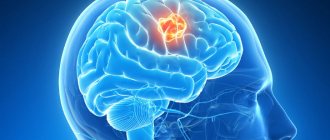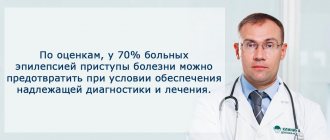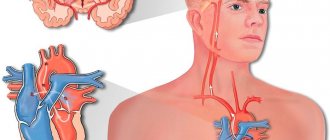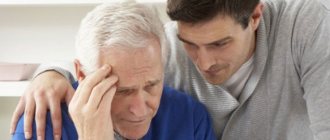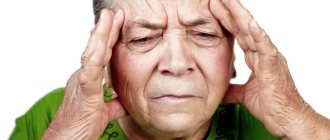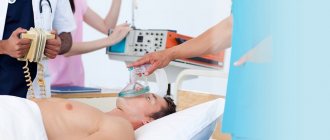Stroke: clinic and treatment
Treatment of acute stroke will be more successful if you consult a doctor in a timely manner. If you or a loved one:
- concerns about dizziness, nausea, weakness or numbness in the limbs;
- there were difficulties in swallowing, speech functions were impaired;
- drowsiness, inability to adequately respond to what is happening around;
- inability to maintain a stable position, impaired consciousness.
In this case, a hemorrhagic or ischemic stroke of the brain can be suspected in time, the treatment of which should be carried out only in a hospital setting.
System of assistance to patients with stroke in Moscow
Every year in Russia more than half a million people suffer a stroke. At the same time, only 18 percent of patients visit doctors on time. In Moscow, to more effectively combat this disease, the Department of Health has created a stroke network of operational assistance based on vascular centers. In December, the network’s clinics will begin performing the first emergency operations to remove blood clots. On the eve of the Day against Stroke, which is celebrated on October 29, the capital's chief neurologist Nikolai Shamalov spoke about how to recognize the insidious disease and what kind of help Muscovites can count on.
— Nikolai Anatolyevich, tell us, how many strokes happen in Moscow?
— In Moscow, more than 42 thousand people are admitted to the hospital every year with acute cerebrovascular accidents, which include not only strokes, but also transient ischemic attacks, that is, what is popularly called a microstroke.
It is important to see a doctor within the first 4.5 hours after signs of illness appear.
Stroke is closely related to age: the older the person, the higher the risk. For example, for people over 55, the risk of having a stroke doubles every decade of their life. The most common type is ischemic stroke (caused by a blood clot), affecting approximately 70 to 80 percent of patients. About 15 percent of patients experience a hemorrhagic stroke (bleeding). Well, 7–15 percent of patients at different periods come to doctors with transient ischemic attacks. Patients tolerate microstrokes more easily, but they are a harbinger of a serious illness, so they require special attention.
Stroke leads among all diseases in disabling people; this is a global statistic, and our country is no exception. This is both a medical and social problem.
— What is the social component of the problem?
“Unfortunately, this disease often leads a person to complete or partial loss of motor, communication and social skills. This places a heavy burden on the patient, his loved ones, and the state, naturally, since additional funds are required to support, treat, and rehabilitate people who have suffered a stroke. The tariff for treatment is 120 thousand rubles. It includes all procedures, medications, care and rehabilitation that are carried out in city medical institutions. These services are paid for from the budget, treatment is provided under the compulsory medical insurance policy.
— Experts say that for successful treatment, it is important to see a doctor as soon as possible at the first signs of a stroke. However, only 18 percent of patients manage to do this. Why is this happening?
— It is important to see a doctor within the first 4.5 hours after signs of the disease appear. This is the therapeutic window that allows doctors to most effectively perform thrombolysis - dissolving a blood clot with the help of drugs. Doctors will deal with the blood clot faster, blood flow will be restored, which means that the brain will not have time to be seriously damaged.
The problem of late presentations is associated with very low public awareness and low literacy of the population regarding stroke symptoms.
Its peculiarity is that there is no painful sensation, even the head does not hurt very often. And pain is a very powerful sentinel reaction for a person; it is because of it that he immediately seeks medical help. With a stroke, unilateral weakness in the arm, leg, and facial asymmetry most often occur. Speech disturbances and decreased (numbness) sensation in the arm and leg on one side of the body may appear. Painlessness of symptoms leads to the fact that a person decides to rest at home and go to the doctor later. That is, unfortunately, most people delay treatment because, firstly, they do not know the symptoms of a stroke, and secondly, simply because there is no acute, bright signal in the form of pain, as happens with some other diseases.
— How is Moscow solving the problem of informing the population about the symptoms of this disease? Is there any effect from this information?
— The Department of Health is doing a lot of work related to informing the population through the media. Stroke schools operate in clinics, where doctors regularly talk about the symptoms of the disease, its treatment and rehabilitation. Clinics also distribute information materials in the form of leaflets, brochures, and booklets. The next classes, for example, will take place on October 29 - Stroke Day. On the same day, in all health centers of city clinics, it will be possible to consult with neurologists, undergo an ultrasound examination of the great vessels of the head and screening to identify risk factors for stroke.
Of course, the medical community also uses social networks to inform people. Thus, advice, banners and pictures are distributed on social networks to attract attention, which list the signs of a stroke.
I would like to note that in Moscow the number of people informed about this disease, its symptoms and methods of treatment has increased. Among those who seek help from doctors in the first 4.5 hours, the figure is already 24 percent, which is six percent more than last year.
HISTORY OF THE ISSUE
The creation of vascular centers reduced the number of deaths from heart attacks by two thirds
— Tell us what kind of help patients receive in Moscow, are there any innovative methods of dealing with stroke?
— Patients with stroke are provided with assistance from regional and primary vascular departments. It is there, in the vascular centers, that the patient is hospitalized for removal of a blood clot or for neurosurgical surgery for hemorrhage. Then, depending on the changes that have occurred (are there any difficulties with speech, movement, perception of information) caused by the stroke, treatment and rehabilitation of the patient in a hospital begins. Rehabilitation continues after discharge as long as it has an effect.
In the near future, a new method of treating patients with ischemic stroke, called “thromboextraction,” will be introduced in vascular centers. Now the blood clot in the vessel is dissolved using drugs and thrombolysis is performed. The essence of the new method is that with the help of special instruments in minimally invasive operations (with minimal intervention
mos.ru
note ) they will surgically remove blood clots. The new technique, like thrombolysis, is recommended by the world expert community as the most effective.
In a number of Moscow hospitals, at the first stages there will be eight departments; the first surgical removal of blood clots will take place in December of this year. Doctors, nurses and staff at vascular centers are completing training in the new method. Thus, the Moscow stroke network is ready for work.
In the near future, a new method of treating patients with ischemic stroke will be introduced in vascular centers
— How exactly is thromboextraction done and which patients is it indicated for?
— Emergency medical teams will receive certain criteria according to which they will evacuate the patient to a unit of the stroke network for possible thromboextraction.
First of all, it will be able to help patients with ischemic stroke without severe disturbances of consciousness, but with a rather severe motor deficit (paralysis. - Note
mos.ru
). That is, these are situations when we have reason at the prehospital stage to assume blockage of a large artery - the very one that is the target of thromboextraction.
The operation will be similar to the placement of a coronary artery stent, which is done in patients with a heart attack. A special stent will be inserted through a puncture in the groin area using a long instrument. Only the path of this stent will not go to the heart, but to the brain. The stent will be able to capture the clot so that doctors can remove it from the vessel. Catheters will also be used to pull the clot out of the vessel.
You need to call an ambulance as soon as possible. You can't eat, drink, smoke, or walk. It is better to lie down and wait for the medical team to arrive. If a person is unconscious, he must be turned on his side to prevent him from suffocating during a possible attack of vomiting. And under no circumstances should you give medication.
Thrombectomy allows you to completely remove the blood clot; such operations reduce mortality from stroke around the world, and patients recover better after them.
In Russia, approximately 19 percent of patients with stroke die, 30 percent of patients remain bedridden after the disease, another 30 percent of patients do not fully return to a full life, the rest manage to fully recover. We hope that with the use of the new technique there will be more people who survive and recover their health.
— Is there a way to minimize the damage from this disease when the first symptoms are detected?
- You need to call as soon as possible, call an ambulance team. You can't eat, drink, smoke, or walk. It is better to lie down and wait for the medical team to arrive. If a person is unconscious, he must be turned on his side to prevent him from suffocating during a possible attack of vomiting. And under no circumstances should you give medications.
Many patients with a stroke have difficulty swallowing, and tablets, water, even a small sip, can get into the lungs. Because of this, pneumonia will then occur. This is a serious complication and can often be fatal. The simplest actions can prevent the development of complications.
When the doctors arrive, you need to quickly and briefly tell them everything you know about the onset of the disease, indicating the exact time of the onset of the disease.
— How often do you need to be examined in order to keep your blood vessels under control and monitor the formation of cholesterol plaques and blood clots in time?
— Firstly, you need to undergo regular medical examinations. Secondly, regularly measure your blood pressure and, if it is higher than the normal value, above 130 to 80, contact your local physician to understand what is the cause and how to further deal with it. Thirdly, people over 40 years of age should regularly, at least once a year, monitor their cholesterol - do a biochemical blood test plus conduct a duplex study of the main arteries of the head. Such measures will allow risk factors to be identified at an early stage and taken under control. All these tests and procedures can be done free of charge as prescribed by a therapist or neurologist in any metropolitan clinic.
Link to publication: https://www.mos.ru/news/item/17454073
Effective treatment of stroke: innovative technologies to protect your health
Therefore, the global medical community has developed not only a program whose goal is to prevent stroke, treating the consequences and restoring the body takes a large part in their research. Our specialists take an active part in scientific research and have created their own effective program that literally gets patients back on their feet. Modern treatment makes it possible to restore the functionality of the limbs, relieve dizziness and dysfunction of the speaking apparatus. Of course, once a stroke is diagnosed, hospital treatment becomes mandatory.
We are able to bring an atmosphere of home comfort into a hospital environment and provide psychological comfort to the patient. The stroke treatment center ensures that the patient will be provided with everything necessary, including equipment for rehabilitation and examination, the involvement of outside specialists and studies will not be needed anywhere else.
Stroke treatment is carried out in Moscow; convenient transportation simplifies contact between relatives and patients, and gives them the opportunity to visit the patient as much as possible and necessary.
Principles of acute stroke treatment:
- 1. Basic therapy - regardless of the nature of the stroke, is aimed at ensuring an optimal level of functioning of physiological systems for the prevention and treatment of respiratory disorders, relief of central hemodynamic disorders with monitoring and correction of oxygenation levels, maintaining adequate blood pressure, cardiac activity, basic parameters of homeostasis, with monitoring for swallowing, the condition of the bladder, intestines, relief of seizures, nutritional support, skin care, passive gymnastics, massage.
- 2. Treatment of concomitant neurological disorders - cerebral edema, acute occlusive hydrocephalus, hemorrhage in the infarction area, dislocation, vasospasm.
- 3. Special methods of treating different types of strokes - systemic or selective thrombolytic therapy, thrombus extraction, surgical methods.
- 4. Rehabilitation measures (starting from the neuroreanimation unit).
- 5. Prevention and treatment of visceral complications - pulmonary embolism (PE), deep vein thromboembolism of the lower extremities.
- 6. Individual secondary prevention of vascular events – medication and surgery.
Neuroprotective therapy for acute stroke should be carried out in the first 3 hours from the onset of stroke, which may determine its effectiveness.
Neuroprotective therapy has certain goals:
- Reducing the size of cerebral infarction;
- Extending the “therapeutic window” period, expanding the possibilities for thrombolytic therapy;
- Protection against reperfusion injury.
Pathogenetic therapy is divided into primary and secondary neuroprotection.
Stroke treatment: what do we offer?
In order to completely eliminate a cerebral stroke, treatment must be carried out under the supervision of highly professional doctors. Specialization of our doctors:
- Ischemic stroke of the brain, the treatment of which is quite successful even in very complex cases when one side of the body is paralyzed.
- Hemorrhagic stroke is a disease whose course is not accompanied by paralysis, but nevertheless requires an immediate response from doctors. The slightest delay or lack of professionalism can lead to disability, so do not experiment - call us immediately.
Upon entering our clinic, the patient immediately undergoes simple and perfusion computed tomography, as well as tomography of the neck vessels. The drug treatment for stroke depends on the results of the examination. Also, if necessary, invasive diagnostic angiography is performed, which will determine the location and size of the blood clot. Also, during the procedure, the blocked artery can be cleared mechanically.
In each specific case, depending on what kind of stroke is diagnosed, the cost of treatment may vary. The recovery plan is developed individually.
If a cerebral stroke is diagnosed, treatment may include:
- Drug therapy that will expand the lumen in the vessel and allow blood to flow freely.
- Surgery, including anatomical bypass, arotid endarterectomy of cerebral vessels, or installation of stent grafts in the carotid artery.
- Physiotherapy and rehabilitation treatment after a stroke will allow you to gain the opportunity to lead a full life. Exercise therapy specialists work with each patient according to an individually developed program for getting rid of the consequences of a stroke, which makes treatment even faster and more effective.
We cannot always predict the development of the situation, but we can say one thing for sure - stroke treatment in the hospital is carried out by doctors who make every effort to achieve a high result. We work to ensure that you live a full life.
Terms of rehabilitation
The recovery period should be at least 21 days. Our program is designed for 30 days, during which the patient undergoes intensive therapy aimed at regaining his independence, the ability to clearly express his thoughts, and be emotionally resilient to the perception of difficulties arising as a result of the disease. If you urgently seek help from a rehabilitation center (within 20 days after a stroke), the patient has a great chance of a full recovery and return to a full life.
In the treatment process, an integrated approach is important: you cannot only work on restoring speech, moving an arm or leg, or improving memory. We make sure that during therapy all systems of the body are involved: only in this case can we guarantee a sustainable result of the treatment regimen used. Comprehensive work on recovery after a stroke at the Moscow rehabilitation center is also aimed at preventing relapse of the disease. Our task is to return to the patient the lost functions of movement, speech, perception and at the same time, to instill in him the confidence that he can continue to live a full life, despite the difficulties that arise.
Minimally invasive surgery: gentle treatment after ischemic stroke
One of the most common ways to neutralize the consequences of a stroke is treatment using a technology such as thrombolysis. During an angiogram, a drug is injected directly into the area where the blood clot has formed. The blockage disappears and blood circulation is restored.
Additionally, drugs are introduced that improve metabolic processes in the brain, so that after a stroke, treatment is faster and more effective. Delay is unacceptable; a diagnosis such as stroke can be treated in a hospital well with a timely response from doctors, when the brain has not yet received irreversible damage.
Symptoms
A stroke has several characteristic signs:
- Speech impairment.
- Paralysis of the face and limbs (often on one side).
- Sudden weakness.
- Sudden loss of vision.
- Gait disturbance, loss of balance.
- Acute headache.
- Dizziness.
If such symptoms appear, an ambulance should be called immediately. Timely actions by doctors will help minimize the consequences of a stroke. In general, symptoms can be divided into cerebral and focal. The former are associated with damage to the brain (dizziness, a state of agitation or weakness), the latter - with the affected area of the brain (loss of vision, displacement of the pupil, speech impairment, stiffness of the muscles in the back of the head).
If treatment is started within three to six hours after the stroke, a favorable outcome for the patient can be hoped for.
Check your predisposition to stroke at Clinic No. 1
- Neurologist appointment
- MRI
- CT
- Ultrasound of brain and neck vessels
- ECG
- Angiography
- Holter monitoring
For one-time payment for services - 20% discount
Call
Physiotherapy: stroke treatment, inpatient rehabilitation
How else can modern medicine help? Stroke treatment and rehabilitation must be comprehensive, including physical therapy. Stimulation of the nervous system will help restore brain cells and restore lost functions to a person.
Once a left-sided stroke is diagnosed, treatment may include:
- massage;
- classes with a neuropsychologist and psychotherapist;
- physical exercise.
Not everything, of course, depends on the doctors - recovery will be faster if the patient himself makes every effort and does not give up. For our part, we will make every effort to create a favorable atmosphere.
The page is for informational purposes only. Find out the exact list of services provided and the specifics of the procedures by calling.
Rehabilitation after stroke
To reduce the risk of complications and speed up a person’s return to a full life, it is very important to carry out early rehabilitation at the stage of the acute period of the disease. It includes physical therapy, massage, breathing exercises and, if necessary, restoration of lost functions.
As mentioned earlier, the basis for successful treatment of stroke is the rapid hospitalization of the patient in a medical facility. And if a person’s life is really important to you, you should turn to us for help, because only we carry out hospitalization to the clinic in just 15 minutes! You can call us for help 24 hours a day by calling our hotline.
Treatment of ischemic cerebral stroke with neuroprotectors
Currently, there are many drugs that have a neuroprotective effect. Doctors at the Yusupov Hospital use only neuroprotectors, the effectiveness of which has been proven by scientific research, to treat ischemic stroke. One of these drugs, which has the most versatile mechanisms of action in relation to oxidative stress (damage to brain cells as a result of oxidation) and a wide evidence base for ischemic stroke, is EMHPS (ethyl-methyl-hydroxypyridine succinate).
In this case, based on clinical experience in the use of EMGPS, the following scheme for its administration is used:
- at the prehospital stage, 400 mg is administered intravenously as a bolus once;
- in the acute period of ischemic stroke (up to 14 days), 5 mg/kg/day is administered intravenously, but more than 800 mg/day;
- during the recovery period (within 14 days), 400–800 mg of the drug 2-3 times a day is administered intramuscularly or intravenously.
One of the mechanisms of the damaging effect of ischemia is cholinergic insufficiency. With pathology of cerebral vessels, the number and size of cholinergic neurons in brain structures decreases. Neurologists at the Yusupov Hospital use the following regimen for the use of choline alfoscerate for acute ischemic stroke: for the first 3-7 days, 1000 mg is administered intravenously 2 times a day, and from the second week they switch to taking 400 mg of the drug per day 2 times a day (course of treatment - 2 month).
The combination of ethyl-methyl-hydroxypyridine succinate and choline alfoscerate in the context of ischemic stroke allows doctors at the Yusupov Hospital to fully influence the fundamental mechanisms of the development of clinical symptoms associated with ischemia and cholinergic insufficiency.
Drugs with proven effectiveness in ischemic stroke include the cerebroprotector Citicoline. Doctors at the Yusupov Hospital use it for both primary and secondary neuroprotection. Primary protection of brain cells begins from the first minutes of ischemia and continues during the first three days of stroke, especially active during the first twelve hours. Secondary neuroprotection reduces the severity of long-term consequences of ischemia. Neurologists begin it 3-6 hours after the onset of a stroke and carry it out for at least seven days.
